Have you ever wondered how to restore vintage cast iron cookware to its former glory? Or are you looking for ways to preserve your aged cast iron collection? We often underestimate the value and potential of these durable kitchen heirlooms, but with the right techniques, they can become functional pieces of art.
When it comes to vintage cast iron cookware, there’s more than meets the eye. These pans, with their smooth finishes and lighter weight compared to modern counterparts, offer a unique cooking experience. They also serve as a tangible connection to America’s industrial history, reflecting the craftsmanship of a bygone era. But how can we restore these pieces and unlock their full potential?
In this guide, we will walk you through the process of restoring vintage cast iron cookware, providing expert techniques and tips. From finding the right pieces to cleaning, seasoning, and maintaining them, you’ll discover how to preserve the beauty and functionality of your treasured cast iron collection.
Join us as we embark on a journey to breathe new life into these timeless kitchen companions. Let’s uncover the secrets behind restoring vintage cast iron cookware, ensuring that these cherished pieces continue to bring joy and flavor to our culinary adventures.
Finding Vintage Cast Iron Cookware
The first step in restoring vintage cast iron cookware is finding the right pieces. There are many brands and manufacturers to consider, such as Griswold, Wagner, and Favorite. Researching these brands and familiarizing yourself with their logos and manufacturing processes can help you identify valuable vintage cast iron cookware.
When evaluating a piece, look for cracks, pits, warping, and surface rust. While some flaws are manageable, extensive pitting, warpage, or heat damage may render a pan unusable. It’s also important to determine if the pan is made of plain cast iron, as certain coatings or materials may affect its ability to be seasoned. Ultimately, the decision to purchase a piece for restoration should be based on its condition and your willingness to invest time and effort into the restoration process.
Identifying Valuable Vintage Cast Iron Cookware
- Research the various brands and manufacturers, such as Griswold, Wagner, and Favorite.
- Look for distinct logos or markings on the cookware.
- Familiarize yourself with the manufacturing processes used by different brands.
Evaluating the Condition of Vintage Cast Iron Cookware
- Inspect the cookware for cracks, pits, warping, and surface rust.
- Consider the extent of damage and whether it is reparable through restoration.
- Check if the pan is made of plain cast iron or has coatings that may affect seasoning.
Deciding on a Restoration Project
- Weigh the condition of the cookware against your willingness to invest time and effort into the restoration process.
- Consider the potential value and significance of the vintage piece.
- Determine if the restoration aligns with your personal interests and goals.
Restoring and Seasoning Techniques
Once you have obtained a piece of vintage cast iron cookware in need of restoration, there are several methods you can use to clean and season it. One common approach is to use a lye bath or an oven cleaner like Easy-Off to remove old layers of seasoning and rust. This process involves soaking the pan in a solution and then scrubbing it with a heavy-duty scouring pad. It may require multiple applications to fully strip the pan.
For more advanced restoration, techniques like electrolysis or a molasses soak can be effective in removing rust and grime. These methods are particularly useful for heavily rusted or neglected pieces. Electrolysis involves the use of an electricity-based process to draw out rust, while a molasses soak utilizes the natural properties of the molasses to dissolve rust over time.
After cleaning, it’s essential to season the cast iron to create a non-stick surface. This involves heating the pan, applying a thin layer of oil or fat, and baking it at high temperatures to polymerize the oil onto the pan’s surface. The seasoning process helps to create a protective layer that prevents moisture from coming into direct contact with the cast iron, reducing the risk of rust formation.
By following these cast iron cleaning tips and using the best methods for cast iron restoration, you can successfully refinish old cast iron pieces and bring them back to their original glory. With proper care and maintenance, your vintage cast iron cookware will continue to provide you with years of reliable use and culinary enjoyment.
